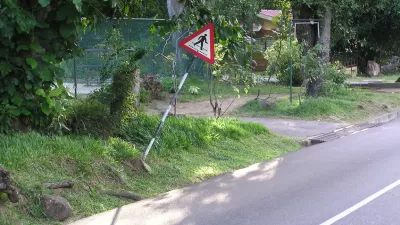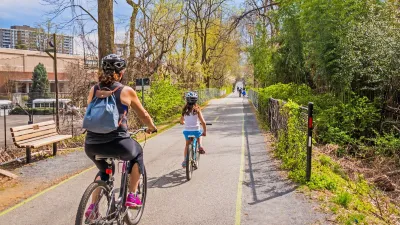The city of Santiago, Chile offers a cautionary tale for cities amidst a biking boom that don’t rethink the mode balance on their streets: there’s nowhere for bikers to go except the sidewalk.
Catesby Holmes reports on the curious case of Santiago, Chile, where “the share of daily commuters who travel by bicycle is increasing 20 percent annually, cyclist fatalities are dropping (34 percent between 2011 and 2012), and bike-share is expanding (now in three neighborhoods). An estimated 800,000 santiaguinos get around town on two wheels.”
But there’s a catch: “With 133 miles of ciclovías, Santiago surpasses many peers but lags well behind Bogotá (233 miles), a similarly sized city. Its network also suffers numerous deficiencies, say bikers: lanes end abruptly, swerve around lamp posts, and cross ungraded sidewalks. The 45 mph speed limits on urban arteries increase the risk of cyclist death in a collision.”
“Facing such challenges, many cyclists have taken to Santiago’s sidewalks.”
Holmes’s coverage includes data about the surprising number of the city’s riders on the sidewalks, as well as comparisons between the design of bicycle networks in bike-friendly cities like Bogotá and Mexico City.
FULL STORY: When Does a Cycling Boom Go Wrong? When Everyone Rides on the Sidewalk

Study: Maui’s Plan to Convert Vacation Rentals to Long-Term Housing Could Cause Nearly $1 Billion Economic Loss
The plan would reduce visitor accommodation by 25% resulting in 1,900 jobs lost.

Alabama: Trump Terminates Settlements for Black Communities Harmed By Raw Sewage
Trump deemed the landmark civil rights agreement “illegal DEI and environmental justice policy.”

Why Should We Subsidize Public Transportation?
Many public transit agencies face financial stress due to rising costs, declining fare revenue, and declining subsidies. Transit advocates must provide a strong business case for increasing public transit funding.

Paris Bike Boom Leads to Steep Drop in Air Pollution
The French city’s air quality has improved dramatically in the past 20 years, coinciding with a growth in cycling.

Why Housing Costs More to Build in California Than in Texas
Hard costs like labor and materials combined with ‘soft’ costs such as permitting make building in the San Francisco Bay Area almost three times as costly as in Texas cities.

San Diego County Sees a Rise in Urban Coyotes
San Diego County experiences a rise in urban coyotes, as sightings become prevalent throughout its urban neighbourhoods and surrounding areas.
Urban Design for Planners 1: Software Tools
This six-course series explores essential urban design concepts using open source software and equips planners with the tools they need to participate fully in the urban design process.
Planning for Universal Design
Learn the tools for implementing Universal Design in planning regulations.
Smith Gee Studio
Alamo Area Metropolitan Planning Organization
City of Santa Clarita
Institute for Housing and Urban Development Studies (IHS)
City of Grandview
Harvard GSD Executive Education
Toledo-Lucas County Plan Commissions
Salt Lake City
NYU Wagner Graduate School of Public Service




























